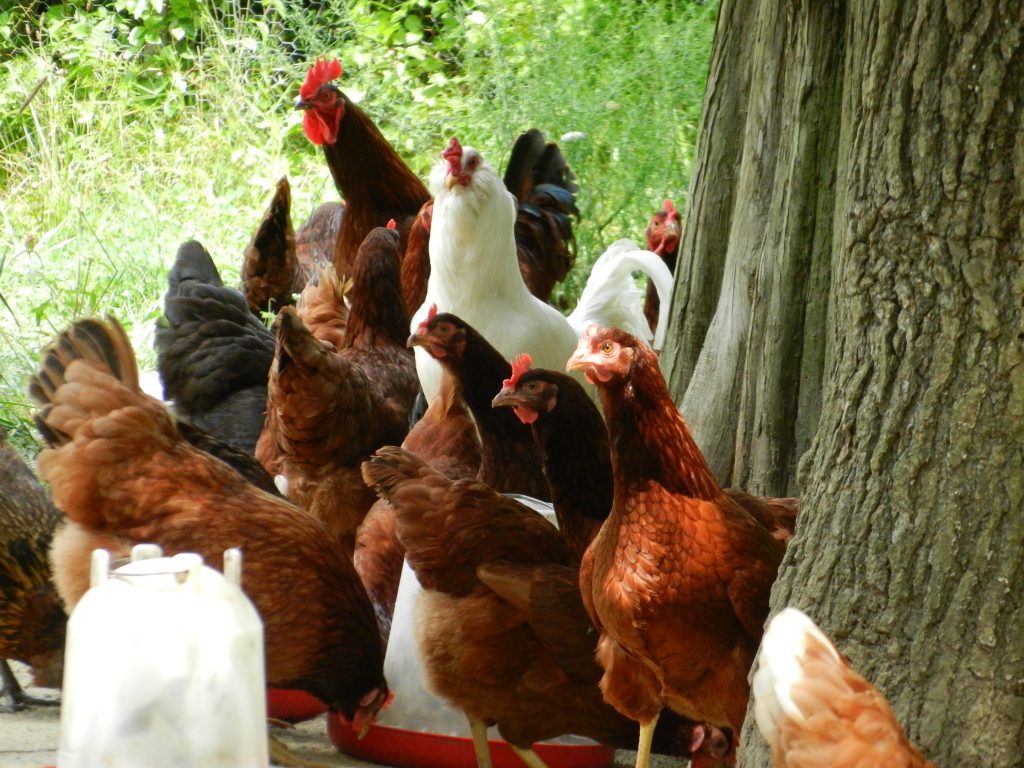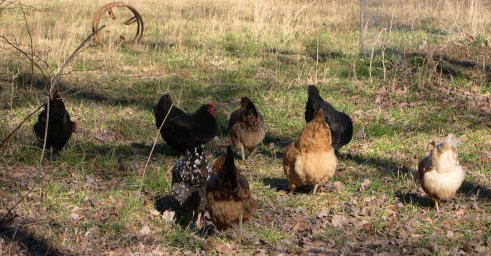This wonderful question showed up as a search term in our site stats and I thought I should answer it in case that viewer came back.
The short answer is “probably” and the longer answer is “it’s complicated.”

In general, hens begin to lay when between 18 and 22 weeks of age. From about 24 and 30 weeks of age, the hens reach their highest production levels and often lay eggs with double or even triple yolks. After this time the egg production drops slowly but become more predictable and most eggs will have single yolks.
In the beginning, the eggs are very small but they become larger, reaching their largest weight (eggs are “sized” by weight) about 50 weeks after the first egg is laid.
An egg takes approximately 25.5 hours to develop from ovulation to lay, and ovulation begins again 30 minutes after an egg is laid. This means we should expect an egg every 26 hours.
At about 18 months old the hens experience a moult that slows or stops egg production while all of the hen’s feathers are dropped and replaced with new ones. After this moult, the egg production slows down and future moults will be yearly with additional drops in production.
None of the things above is changed by free-ranging. Things that do affect the above are the breed of hen, genetics of individual hens within a breed, day-length, feed, water, stress, and broodiness.
Here’s where it gets complicated. What do we mean by fewer eggs? If the question is “Do free-ranging chickens lay fewer eggs per year than hens in a commercial egg production facility?” The answer is probably yes. Yes, because in a battery cage or deep litter situation, the factors that affect production are closely managed. Artificial light is used to trick the birds into laying normally through the short days of winter. Commercial, non-free ranging, hens are usually selected from breeds that are not prone to becoming broody. Poorly laying or older hens are routinely culled in containment settings. Moulting is often forced by with-holding feed and lowering the light (although for the life of me I cannot see the purpose of this). In theory, these things could be controlled in a free-range situation.
If that didn’t complicate things enough, we have to also consider that the USDA has no definition for free-range as it pertains to egg production. Organic eggs must be from chickens with “year-round access to the outdoors” but only as long as the weather is nice. Free-range, as it pertains to our hens, is defined as “I close the door at night to keep you safe, if you miss curfew you had better find a safe spot to roost.”
If the question is “Do your free-ranging hens lay fewer eggs than hens in a commercial egg production facility?” The answer is yes, absolutely! For our own flock, we choose about half of the hens for productivity, about a quarter for green/blue eggs and the remaining quarter for temperament, other egg colours, egg size etc. So from the very beginning, we know that our free-ranging hens will not lay as many eggs as a flock of just Rhode Island Reds or White Leghorns. We also know that by allowing them to run around outside all day they will not get the 14-16 hours of daylight every day that is needed for peak production. We chose not to put a light in the hen-house even though it would increase winter production. We do not cull poor layers, we have breeds who get broody.
Finally, if the question is “Do your free-ranging hens layer fewer eggs over their lifetime than hens in a commercial egg production facility?” The answer is a resounding “NO.” Because we do not cull, the average lifespan of our laying hens is about 6 years. We have had some who live to be 9 or 10 years old, but of course, we lose some to predation and that brings down the average. We do not track which hen lays which egg (although I expect that is tracked with caged hens), but the University of Florida IFAS Extension has a nice little chart that shows egg production as a hen ages as a percentage of her first year of production and Perdue University Food Animal Education Network gives us 325 as the average number of eggs produced by one hen in 2009 (I hope it wasn’t the same hen who averaged 160 eggs in 1960).
| Year 1 | Year 2 | Year 3 | Year 4 | Year 5 | Year 6 | Year 7 | Year 8 | Year 9 | Year 10 | Lifetime | |
|---|---|---|---|---|---|---|---|---|---|---|---|
| Percent | 100.00 | 83.00 | 66.00 | 60.00 | 50.00 | 42.00 | 32.00 | 31.00 | 22.00 | 20.00 | Total |
| My Oldest Hen | 325 | 270 | 214 | 195 | 162 | 136 | 104 | 101 | 71 | 65 | 1643 |
| My Hen | 325 | 270 | 214 | 195 | 162 | 136 | 1302 | ||||
| Their Hen | 325 | 270 | 595 |





Great info. My husband changed the nesting boxes so the eggs drop because a couple were eating them. That helped. We then had one injured so he put her, she s a bantom so she fit, in a cat carrier for a couple days. He left it for her to hide out but soon discovered the other chickens, large ones, were using it. Seems all eggs are now layed in the cat carrier. Chickens are definitely interesting!
Sorry, not a comment, but a question I hope you will answer.
Given the extreme stress a caged hen is under; why does it lay eggs at all?
That’s a really good question and I have to admit I don’t know the answer. Presumably the hens housed in those cages have been selectively bred to be the best layers in that environment despite the extreme stress. Perhaps there is a level of nutrition that triggers laying in spite of all other factors. I’m guessing here as I have no experience whatsoever with caged animals and can only observe the behaviour of our free ranging hens.
Hi Sam, egg-laying hens have been selectively bred to produce huge amounts of eggs (naturally they would produce 12-15 a year – similar to human egg production) and their food is designed to promote it as well. They have no choice really. They are a travesty of the original bird that they’ve been bred from and only live to about 18 months when they’re sent for slaughter. Their egg laying has diminished to a non-profitable amount so they’re killed.